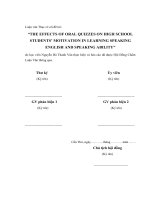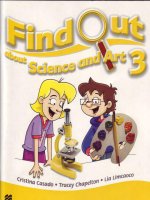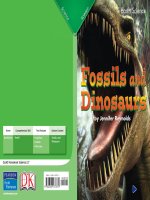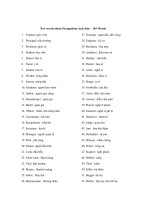learning about fossils and dinosaurs
Bạn đang xem bản rút gọn của tài liệu. Xem và tải ngay bản đầy đủ của tài liệu tại đây (2.85 MB, 12 trang )
Genre Comprehension Skill Text Features Science Content
Nonfi ction Use Graphic
Organizers
• Captions
• Labels
• Diagram
• Glossary
Fossils and
Dinosaurs
Scott Foresman Science 2.7
Standards
Preview
Standard Set 3. Earth Sciences
3. Earth is made of materials that
have distinct properties and provide
resources for human activities. As the
basis for understanding this concept:
3.d. Students know that fossils provide
evidence about the plants and animals
that lived long ago and that scientists
learn about the past history of Earth
by studying fossils.
ISBN 0-328-23514-8
ì<(sk$m)=cdfbei< +^-Ä-U-Ä-U
23514_CVR.indd Cover123514_CVR.indd Cover1 2/1/06 1:55:41 PM2/1/06 1:55:41 PM
Earth Sciences
by Kristin Cashore
23514_CVR.indd Cover223514_CVR.indd Cover2 2/1/06 1:55:50 PM2/1/06 1:55:50 PM
Vocabulary
dinosaur
fossil
skeleton
Picture Credits
Every effort has been made to secure permission and provide appropriate credit for photographic material. The
publisher deeply regrets any omission and pledges to correct errors called to its attention in subsequent editions.
Unless otherwise acknowledged, all photographs are the copyright of Dorling Kindersley, a division of Pearson.
ISBN: 0-328-23514-8
Copyright © Pearson Education, Inc. All Rights Reserved. Printed in the United States of America.
This publication is protected by Copyright, and permission should be obtained from the publisher prior to any
prohibited reproduction, storage in a retrieval system, or transmission in any form by any means, electronic,
mechanical, photocopying, recording, or likewise. For information regarding permission(s), write to
Permissions Department, Scott Foresman, 1900 East Lake Avenue, Glenview, Illinois 60025.
1 2 3 4 5 6 7 8 9 10 V010 13 12 11 10 09 08 07 06
23514_CVR.indd Cover323514_CVR.indd Cover3 1/13/06 12:05:26 PM1/13/06 12:05:26 PM
by Kristin Cashore
23514_001-020.indd 123514_001-020.indd 1 1/13/06 12:11:55 PM1/13/06 12:11:55 PM
2
Learning About
Fossils
Do you know what a fossil is? A fossil is a
print or part of a plant or animal that lived long
ago. Some fossils are shapes that have been
left in rocks. Other fossils are very old bones or
teeth.
Fossils show what
plants and animals
looked like long ago.
23514_001-020.indd 223514_001-020.indd 2 1/13/06 12:12:02 PM1/13/06 12:12:02 PM
3
There are scientists who study fossils. These
scientists want to know more about plants and
animals. They want to fi nd out what living
things from long ago looked like.
These scientists are
working with fossils.
23514_001-020.indd 323514_001-020.indd 3 1/13/06 12:12:16 PM1/13/06 12:12:16 PM
4
What Fossils Show
Fossils show the size of living things from
long ago. They show the shape of living things
from long ago. There are fossils of plants and
animals that no longer live on Earth.
This is a fossil of a shell.
Long ago an animal
lived in the shell.
23514_001-020.indd 423514_001-020.indd 4 1/13/06 12:12:20 PM1/13/06 12:12:20 PM
5
A Fossil Forms
An animal dies.
Sand and mud cover
the body.
The sand and mud
turn into rock.
23514_001-020.indd 523514_001-020.indd 5 1/13/06 12:12:23 PM1/13/06 12:12:23 PM
6
Life Long Ago
Scientists can help teach us about life from
long ago. Fossils show things about the past.
The scientists below are working with fossils.
They are using special tools to clean the fossils.
These scientists are working
carefully. Fossils can break easily!
23514_001-020.indd 623514_001-020.indd 6 1/13/06 12:12:27 PM1/13/06 12:12:27 PM
7
Sometimes scientists fi nd fossils of bones.
The scientists might put the fossil bones together
to make a skeleton. A skeleton is all the bones
of a body.
Scientists build dinosaur
skeletons from fossils of bones.
23514_001-020.indd 723514_001-020.indd 7 1/13/06 12:12:44 PM1/13/06 12:12:44 PM
8
Learning about Dinosaurs
Dinosaurs were animals that lived on Earth
long ago. Scientists study dinosaur fossils.
Scientists want to know how dinosaurs lived
and what they looked like.
Fossils help us see
what dinosaurs might
have looked like.
23514_001-020.indd 823514_001-020.indd 8 1/13/06 12:12:48 PM1/13/06 12:12:48 PM
9
We can see how Earth has changed over
time by looking at fossils. Here you see a
picture of dinosaurs. Earth might have once
looked like this.
Dinosaurs lived
many years ago.
23514_001-020.indd 923514_001-020.indd 9 1/13/06 12:12:58 PM1/13/06 12:12:58 PM
10
Finding New Dinosaurs
Scientists look for fossils in many places. We
can learn new things by fi nding fossils.
Scientists found two dinosaur skeletons in
Morocco. One of the dinosaurs was called
Carcharodontosaurus.
Carcharodontosaurus
had a big skull. A human
skull is much smaller!
23514_001-020.indd 1023514_001-020.indd 10 1/13/06 12:13:05 PM1/13/06 12:13:05 PM
11
The other dinosaur was called
Deltadromeus. It was very long. Its arms and
legs were long and thin. Deltadromeus and
Carcharodontosaurus both ate meat.
This
Deltadromeus
skeleton is at
a Chicago museum. Compare it
to the human skeleton.
23514_001-020.indd 1123514_001-020.indd 11 1/13/06 12:13:09 PM1/13/06 12:13:09 PM
12
What do we know
about dinosaurs?
Scientists have learned a lot about dinosaurs.
Some dinosaurs were very small. Some
dinosaurs were very big.
The
Diplodocus
was huge!
23514_001-020.indd 1223514_001-020.indd 12 1/13/06 12:13:12 PM1/13/06 12:13:12 PM
13
There were once many kinds of dinosaurs on
Earth. No dinosaurs are alive today.
The
Coelophysis
was tiny.
Triceratops
had horns.
23514_001-020.indd 1323514_001-020.indd 13 1/13/06 12:13:21 PM1/13/06 12:13:21 PM
14
What Dinosaurs Ate
Scientists want to know what dinosaurs ate.
So they study dinosaur teeth. Scientists learn
what dinosaurs ate from their teeth.
Tyrannosaurus rex
had
sharp teeth. It ate meat.
23514_001-020.indd 1423514_001-020.indd 14 1/13/06 12:13:30 PM1/13/06 12:13:30 PM
15
Some dinosaurs had teeth that were long
and sharp. These dinosaurs ate meat. Other
dinosaurs had teeth that were short and fl at.
These dinosaurs ate plants.
Barosaurus
ate plants.
It had a long neck like a
giraffe.
23514_001-020.indd 1523514_001-020.indd 15 1/13/06 6:12:09 PM1/13/06 6:12:09 PM
16
Animals Then and Now
Scientists learn about animals from footprints.
Footprints show that some dinosaurs walked on
their toes.
Look at the elephant footprints below.
Elephants walk with their feet and toes fl at on
the ground.
Four-legged
dinosaur
Two-legged
dinosaur
These footprints were
made by an elephant
living today.
Dinosaur footprints
23514_001-020.indd 1623514_001-020.indd 16 1/13/06 12:13:55 PM1/13/06 12:13:55 PM
17
Some birds from long ago were like birds
today. They had feathers and beaks.
Some birds from long ago were not like birds
today. They had sharp teeth and long, bony
tails. Few birds today have these things.
Archaeopteryx
lived
long ago. This bird had
claws on its wings.
23514_001-020.indd 1723514_001-020.indd 17 1/13/06 12:14:06 PM1/13/06 12:14:06 PM
18
Plants Then and Now
Plant fossils show the size of plants from long
ago. They also show the shape of plants from
long ago. Scientists study plant fossils to learn
about plants from the past. They want to know
how these plants are like plants today.
Do these plant fossils
remind you of plants
living today?
23514_001-020.indd 1823514_001-020.indd 18 1/13/06 12:14:14 PM1/13/06 12:14:14 PM
19
Redwood trees lived long ago. Some
redwoods grow today. Redwoods from long
ago looked like redwoods today.
What color were plants long ago? Many
plant fossils are black. But most plants today
are green. Plants from long ago were probably
green as well.
A fern fossil looks a lot like
a fern growing today.
23514_001-020.indd 1923514_001-020.indd 19 1/13/06 12:14:28 PM1/13/06 12:14:28 PM
20
dinosaur animal that lived on Earth long ago
fossil a print or part of a plant or
animal that lived long ago
skeleton all of the bones of a body
Glossary
23514_001-020.indd 2023514_001-020.indd 20 1/13/06 12:14:34 PM1/13/06 12:14:34 PM
What did you learn?
1. Some dinosaurs ate plants. What kind of
teeth did they have?
2. How did many dinosaurs walk?
3.
Write about a time
that you read a book about dinosaurs or saw
an educational television program about
dinosaurs. What did you learn about
dinosaurs from that book or program? Make
sure your answer includes a beginning,
middle, and end, along with specifi c details.
4.
Use Graphic Organizers Write what you
learned about dinosaurs. Use a graphic
organizer to help you.
23514_CVR.indd Cover423514_CVR.indd Cover4 1/13/06 12:05:26 PM1/13/06 12:05:26 PM









